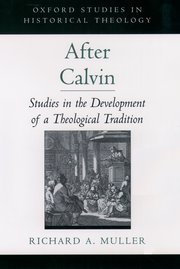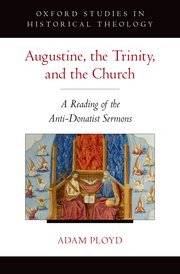
Author’s Corner: Oxford Studies in Historical Theology
Each week on Credo we welcome you to join us in the Author’s Corner where we will meet a set of authors whose recent books deserve your attention and might even help you grow in your knowledge of theology, history, philosophy, and the scriptures. We hope the Author’s Corner can keep you up-to-date on the most important books published today and where you can find them.
On today’s Author’s Corner, we present you with a selection from the Oxford Studies in Historical Theology, edited by Richard A. Muller (Oxford University Press).
Oxford University Press established in 1994 a new series of original monographs devoted to the history of Christian thought from its early and medieval beginnings to its later development in the modern period. The underlying assumption held from the first was that Christian ideas from the past can best be understood when scholars present them in their proper historical and cultural context. For 20 years the distinguished authors in this series have treated a wide variety of intellectual problems from the Christian past and, by so doing, have redefined the discipline of historical theology for the foreseeable future.
A fter Calvin: Studies in the Development of a Theological Tradition (OUP, 2003) by Richard A. Muller
fter Calvin: Studies in the Development of a Theological Tradition (OUP, 2003) by Richard A. Muller
This is a sequel to Richard Muller’s The Unaccommodated Calvin (OUP, 2000). In the previous book, Muller attempted to situate Calvin’s theological work in their historical context and to strip away various twentieth-century theological grids that have clouded our perceptions of the work of the Reformer. In the present book, Muller carries this approach forward, with the goal of overcoming a series of nineteenth- and twentieth-century theological frameworks characteristic of much of the scholarship on Reformed orthodoxy, or what might be called “Calvinism after Calvin.”
A ugustine’s Early Theology of Image: A Study in the Development of Pro-Nicene Theology (OUP, 2016) by Gerald P. Boersma
ugustine’s Early Theology of Image: A Study in the Development of Pro-Nicene Theology (OUP, 2016) by Gerald P. Boersma
What does it mean for Christ to be the “image of God”? And, if Christ is the “image of God,” can the human person also unequivocally be understood to be the “image of God”? Augustine’s Early Theology of Image examines Augustine’s conception of the imago dei and makes the case that it represents a significant departure from the Latin pro-Nicene theologies of Hilary of Poitiers, Marius Victorinus, and Ambrose of Milan only a generation earlier.
Augustine’s predecessors understood the imago dei principally as a Christological term designating the unity of divine substance. But, Gerald P. Boersma argues, Augustine affirms that Christ is an image of equal likeness, while the human person is an image of unequal likeness. Boersma’s careful study thus argues that a Platonic and participatory evaluation of the nature of “image” enables Augustine’s early theology of the image of God to move beyond that of his Latin predecessors and affirm the imago dei both of Christ and of the human person
A ugustine, the Trinity, and the Church: A Reading of the Anti-Donatist Sermons (OUP, 2015) by Adam Ployd
ugustine, the Trinity, and the Church: A Reading of the Anti-Donatist Sermons (OUP, 2015) by Adam Ployd
The legacy of Augustine of Hippo (354-430) continues to shape Western Christian language about both the Trinity and the Church, yet scholars rarely treat these two topics as related in his work. In Augustine, the Trinity, and the Church, Adam Ployd argues that Augustine’s ecclesiology drew upon his Trinitarian theology to a surprising degree; this connection appears most clearly in a series of sermons Augustine preached in 406-407 against the Donatists, the rival Christian communion in North Africa.
As he preached, Augustine deployed scriptural interpretations derived from his Latin pro-Nicene predecessors – but he adapted these Trinitarian arguments to construct a vision of the charitable unity of the Catholic Church against the Donatists. To condemn the Donatists for separating from the body of Christ, for example, Augustine appropriated a pro-Nicene Christology that viewed Christ’s body as the means for ascent to his divinity. Augustine also further identified the love that unites Christians to each other and to Christ in his body as the Holy Spirit, who gives to us what he eternally is as the mutual love of Father and Son. On the central issue of baptism, Augustine made the sacrament a Trinitarian act as Christ gives the Spirit to his own body.
The book ultimately shows that, for Augustine, the unity and integrity of the Church depended not upon the purity of the bishops or the guarded boundaries of the community, but upon the work of the triune God who unites us to Christ through the love of the Spirit, whom Christ himself gives in baptism.

